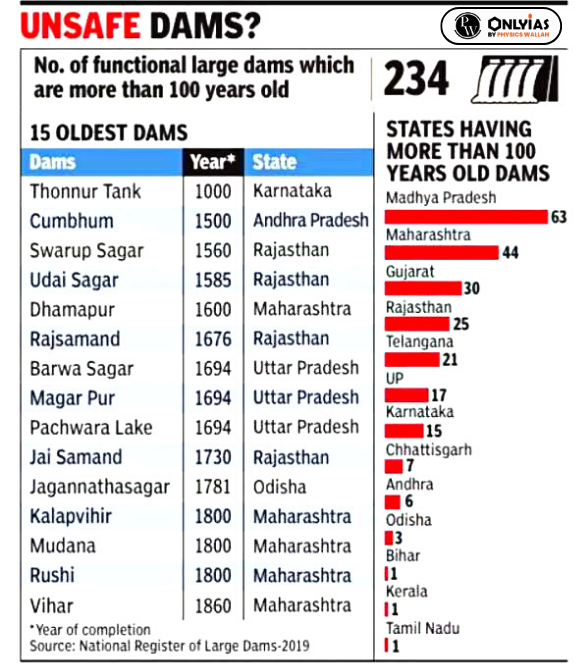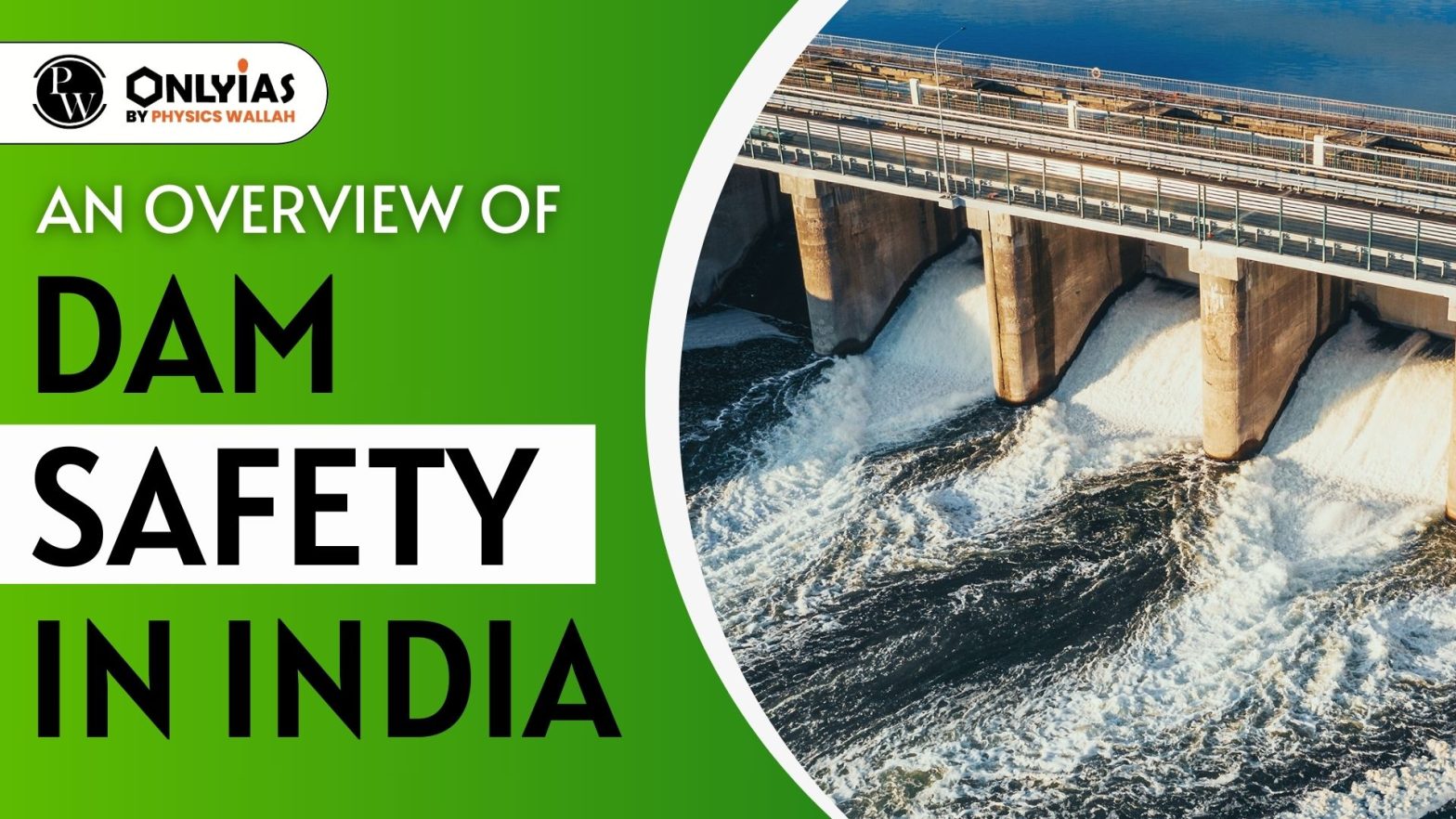Context:
- This article is based on the news “Sikkim review: How safe are dams in India?” which was published in the Mint. The Chungthang dam in Sikkim collapsed recently due to a glacial lake outburst flood (GLOF) killing 30 people.
| Relevancy for Prelims: Dam Safety Act, 2021, ICDS, Water resources in India, and Central Water Commission(CWC).
Relevancy for Mains: Rajasthan International Centre (RIC), India’s Constitutional arrangements and dam safety, Issues associated with dams, and Water Resources Information System (WRIS). |
International Conference on Dam Safety (ICDS)
- The dam was about 20 years old and several environmental concerns had been raised over the years about the formation of glacial lakes and likely GLOFs.
- International Conference on Dam Safety (ICDS): It was recently organized by the Ministry of Jal Shakti at the Rajasthan International Centre (RIC) in Jaipur which laid emphasis on the issue of dam health and safety.
Why do we need dam safety in India?
- Dam failure: The International Commission on Large Dams (ICOLD) defines dam failure as the collapse or movement of part of a dam or its foundation so that the dam cannot retain water.
- Such failure may be caused by age, construction deficiencies, inadequate maintenance, extreme weather or seismic events, and faulty operation.
- Threats from dam failure: Unhealthy dams pose significant threats to human life, crops, houses, buildings, roads, the environment and the economy.
- Therefore, dam safety is a matter of utmost and universal importance.
- Dams on interstate rivers: Ninety-two percent of India’s large dams have been built on inter-state rivers.
- The negative repercussions of a dam’s hazard potential may spill over to other States and even other countries.
India’s Constitutional arrangements and dam safety
- Entry 56 of List I: It deals with the Union’s legislative power relating to the regulation and development of inter-state rivers and river valleys.
- Entry 17 of List II: secures the State’s legislative power over water. However, it is subject to Entry 56 of List I:
Development of water resources and dams in India
- Role of State governments: Under the 7th Schedule of the Constitution of India, water and water storage is a state subject.
- Therefore, legislating dam safety is the responsibility of state governments.
- Role of Central Government: Central Government can enact legislation governing dams in three scenarios:
- If the project affects multiple states or international treaties: It can pass legislation regulating dams whose catchment area or downstream areas span multiple states or international borders.
- If two or more states pass a resolution requiring such a law: In 2010, Andhra Pradesh and West Bengal passed resolutions requiring a law on dam safety.
- Environment Protection: Matters related to the protection of the environment under the Environment Protection Act, 1986.
|
Also read: List Of Major Dams In India Type, Roles And State Wise
What are the issues associated with dam safety?
- Ineffective compliance of Dam Safety Act, 2021: Only 20 States have constituted the State Committee on Dam Safety (SCDS) in compliance with the provisions of the act.
- Moreover, only 16 States have established the State Dam Safety Organisation (SDSO).
- While state governments are empowered to enact dam safety legislation, only Bihar has enacted Bihar Dam Safety Act, 2006.

- Lack of oversight powers over state departments: At the state level, the respective water resources or irrigation departments are in charge of dam safety.
- They are reported to usually follow Central Water Commission(CWC) standards, but the CWC has no oversight powers over them.
- Lack of clearance mandate for small dams: Dams which have an irrigation command area less than 10,000 Ha or power generation capacity between 50 to 25 MW require a clearance from the state government only.
- They do not require an environmental clearance at all.
- No existing statutory provisions require regular and systematic reporting of dam failures.
- No single agency keeps track of all dam failures: CWC maintains a record of dam failure events but the list is collected from states, and is not regularly updated.
- The Central bill provides that every State Dam Safety Organisation has to report dam failures within its jurisdiction.
- However, there is no details about how these requirements will be implemented and whether states will choose to adopt them at all.
- Dam failure analysis: It is done as part of Environment impact assessment(EIA) for projects requiring environmental clearance from the Ministry of Environment and Forests (MoEF).
- There is no standardization in how dam failure analyses are conducted and reported. While the CWC has developed some guidelines on this, they are not legally binding.
- Performing dam failure analysis is compulsory for getting an environmental clearance for constructing new dams and for modifying/upgrading existing dams.
- There are, however, no regulations for conducting these analyses for dams which are operating but where no new engineering works are being undertaken.
- Structural deficiencies: In India, the State governments and their water and irrigation ministries own most dams and are primarily responsible for their upkeep.
- Many of these dams have structural deficiencies and shortcomings in operation and monitoring.
- In 2017, the Comptroller and Auditor of General of India found that out of the 17 States it audited, only two states conducted pre- and post-monsoon safety audits of their dams.

Central Water Commission(CWC)
- CWC is a premier Technical Organization of India in the field of Water Resources.
- Nodal Ministry: Ministry of Jal Shakti.
|
Also read: India’s First National Waterbody Census
Way Forward
- Legally binding standards for dam failure analysis:
- MoEF needs to institute legally binding standards for conducting and reporting dam failure analysis.
- Regular sharing of dam-related data between the states and the centre: This must include dam failure analysis data and inundation maps.
- These data need to be made publicly available for transparency, and for facilitating research in dam safety and risk mitigation.
- Dam Decommissioning policy: This needs to be put in place for removing or reconstructing dams which cannot be repaired or upgraded.
- It includes removal of hydro-electric generation facilities and recontouring of river channels through ecologically viable interventions in the catchment areas.
- Integrated database: It should link information from dam failure analyses for cleared projects with the static dam-related information from Indian Space Research Organisation (ISRO)’s Water Resources Information System (WRIS).
- Pan-India statutory framework for reporting and recording dam failure events: For this, India needs to enact legislation, and put in place systems for regular reporting of dam failure events.
- Neither is there a centralized repository for information regarding dam failure events. As a result, many dam failure events go unreported.
- Risk-based decision-making system: It needs to be developed for making objectively sound decisions on all aspects of dam design, construction and operation like those used in Australia and USA.
How can India benefit from studying the practices of China’s Dam Safety Management Centre?
- The Ministry of Water Resources in China created the Dam Safety Management Centre under the Nanjing Hydraulic Research Institute, and Large Dam Safety Supervision Centre to conduct dam safety assessments and research in dam safety, and for development of standards and regulation.
- Through research, China has developed sophisticated risk management systems for mitigating risks of dam failure.
|
Conclusion
Ensuring the safety of dams is crucial for protecting lives, the environment, and the economy. India needs robust legislation, standardized analyses, and transparent reporting mechanisms to address dam safety challenges and prevent potential disasters.
| Attempt the PY Prelims Question
On which one of the following rivers is the Tehri Hydropower Complex located?
- Alaknanda
- Bhagirathi
- Dhauliganga
- Mandakini
Ans: B |



